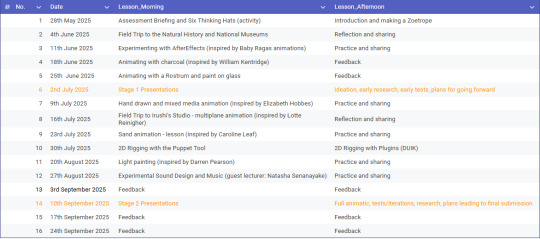Don't wanna be here? Send us removal request.
Text
RESEARCH: Edward de Bono's Six Thinking Hats
The Six Thinking Hats is a technique developed by Maltese psychologist Edward de Bono. It is designed to help you consider a problem from six different directions, to give you a more rounded perspective of an issue than you would gain from just looking at it through the lens you would instinctively use.
The de Bono Group's website describes each hat like this:

This is also the principle we are meant to explore in our final submission for this module, approaching the chosen topic through six separate lenses.
[28/05/2025]
6 notes
·
View notes
Text
CLASSROOM ACTIVITY #1: Making A Zoetrope
The class split into groups of 3-4 to create our own zoetropes, using materials provided by the lecturer. We used this video from RimstarOrg for instructions.
A zeotrope is an early form of animation technology from the 19th century. A variation of the phénakisticope (an animation disc), the zoetrope consists of a cylinder with vertically cut lines along the sides. The inner surface of the cylinder features a row of sequential images. To see the animation in motion, the viewer must look through the slits while simultaneously spinning the zoetrope by hand. The images rotate rapidly and create the illusion of motion. (via mymodernmet.com)
My group, consisting of myself, Minuthi, and Thesandu, used our zoetrope to animate a short walk cycle.
[28/05/2025]
5 notes
·
View notes
Text
LESSON 01: INTRO TO EXPERIMENTAL ANIMATION
In the first class for this module, we shared work we'd done over the last semester, as well as what we'd most enjoyed and what we'd most struggled with.
In the afternoon class, we explored definitions of experimental animation, discussed Edward DeBono's Six Hats, and watched a few short pieces from animators who worked with non-traditional mediums, such as

The Owl Who Married a Goose: An Eskimo Legend (1974) by Caroline Leaf, which uses sand animation

The Debutante by Elizabeth Hobbs, which uses ink, watercolor, and paper collage

Hello Summer by Martin Smatana and Veronika Zacharova, which uses digital animation in Adobe AfterEffects layered over live-action props
Experimental is a tricky term when applied to animation. Some scholars and artists only apply the term to abstract or non-narrative films. Others use the term more broadly, applying it to animation that uses unusual or innovative production processes, regardless of narrative content. For the purposes of this book, I prefer Jules Engel’s definition: “Experimental Animation is a personal vision - a concrete record of an artist’s discovery of himself.” - from Fluid Frames by Corrie Francis Parks
[28/05/2025]
4 notes
·
View notes
Text
THE BRIEF



Lecturer Irushi's lesson plan for the semester:

[28/05/2025]
3 notes
·
View notes